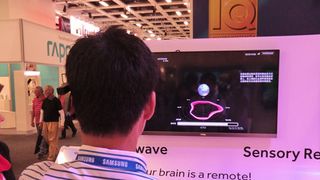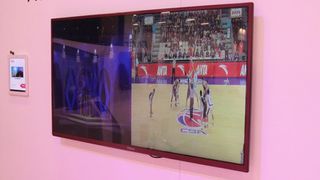You can control Haier's Eye TV using just your eyes
Chinese brand demos TVs of the future

Blink and you'll miss it, but Chinese brand Haier (pronounced 'higher') is demonstrating some hugely innovative TVs on its IFA stand.
A major manufacturer of TVs and huge in its native country, Haier revealed to us probably the only innovation at IFA 2012 that could genuinely change lives; the Eye Control TV.
After calibrating to our eyes using an eye tracking unit made by Tobii, we were able to control a cursor on the TV screen just by looking. We managed to scroll through a carousel of video, change the volume and double-blink to 'click' to activate content.

That said, it worked better at operating a regular Windows 7 interface that the demo was running off, with moving around the page and double-blinking on programmes and documents easy.

Thought control is also part of Haier thinking, with its Brainwave TV - which debuted at the CES back in January - also making an appearance.
Having donned a headset that monitors electrical signals in my scalp, I managed to make a graphic of a ball rise and fall; rise by freeing my mind from thoughts, and fall while concentrating. For now it's a neat prototype, but the real world applications just for entertainment are, err, mind-numbing.
Haier wasn't done there; we passed a gesture-controlled TV, a completely wire-free TV (powered by magnetic resonance coupling in both the TV stand and surface it sat on, with pictures and sound sent over WHDI) and a transparent TV on our way to see a 55-inch Ultra HD model. Everyone's doing it - IFA 2012 is proof of that - but this 4k-capable TV impressed.
Get daily insight, inspiration and deals in your inbox
Get the hottest deals available in your inbox plus news, reviews, opinion, analysis and more from the TechRadar team.

Nearby was a another proof of concept prototype, a 3D Multi-View screen. We've seen this elsewhere - most notably on Samsung's stand where two sets of 3D specs, complete with headphones, allow viewing of two distinctive 2D images. This version uses Polarised 3D specs, but no headphones; it might find use in future if some person wants to search the web on a TV while the other watches TV.
A glasses-less 3D LED was also being demonstrated, this one with 28 separate views thanks to View-Technology, essentially a cylindrical lens, which does appear to make jumps between the line-of-sight less befuddling. 2D footage gets a Full HD treatment, while 3D uses 720p.
Although none were confirmed to come to the UK this year, the Chinese company also unveiled a range of 'Haier Pads' - or HaiPad for short.
The seven-inch Hair-Pad Mini boasts 1024x600 pixel resolution, while the 9.7-inch Hair-Pad Maxi delivers 1024x768; both run on Android 4.0, include mini USB and micro SD, WiFi, 8GB capacity and a mini HDMI output.
Haier also showed a 5.3-inch Android phone-cum-phablet complete with eight megapixel camera, GPS, WiFi and 4GB.
Jamie is a freelance tech, travel and space journalist based in the UK. He’s been writing regularly for Techradar since it was launched in 2008 and also writes regularly for Forbes, The Telegraph, the South China Morning Post, Sky & Telescope and the Sky At Night magazine as well as other Future titles T3, Digital Camera World, All About Space and Space.com. He also edits two of his own websites, TravGear.com and WhenIsTheNextEclipse.com that reflect his obsession with travel gear and solar eclipse travel. He is the author of A Stargazing Program For Beginners (Springer, 2015),

